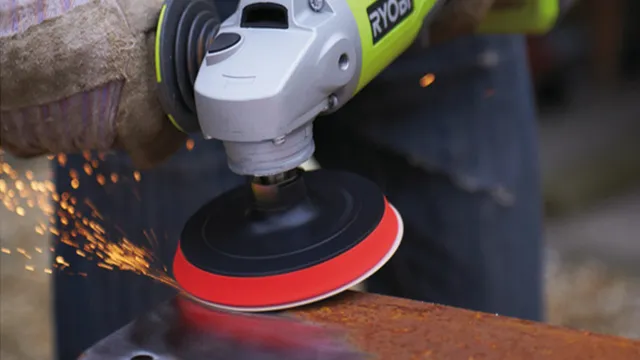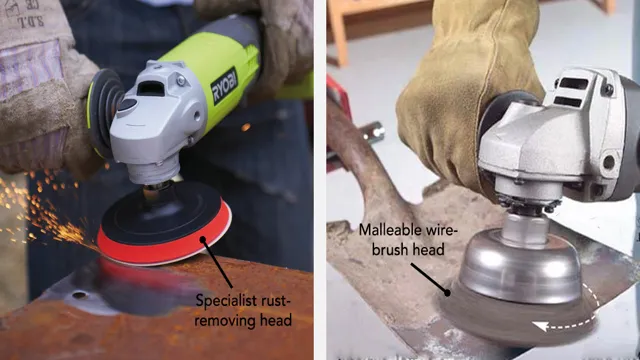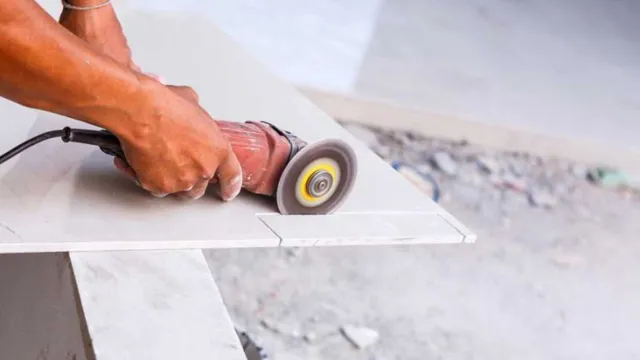Can You Use an Angle Grinder to Cut Plastic? Tips and Techniques to Follow

Do you have a plastic project that requires cutting? Are you wondering if your trusty angle grinder can safely do the job? Well, the answer is yes, an angle grinder can cut plastic but, as with any tool, safety precautions should be taken. Plastic is not as hard as metal, so an angle grinder can easily cut through it. However, plastic can melt if too much pressure is applied, so it’s important to use the proper cutting disc for the job.
Choosing the right cutting disc for your angle grinder will ensure a clean cut without melting the plastic. Safety should always be a priority when using any power tool, including an angle grinder. Wearing eye and ear protection, gloves and a dust mask can protect you from debris and dust generated during use.
It’s important to also have a secure grip on the angle grinder and to position yourself correctly before starting the cutting process. In conclusion, an angle grinder can safely cut plastic, but proper precautions must be taken. By selecting the right cutting disc and adhering to safety guidelines, you can complete your project with ease.
So go ahead and give it a try, your finished product will be worth the effort!
What is an angle grinder?
An angle grinder is a powerful tool that resembles a handheld saw, and is commonly used for cutting, grinding, sanding and polishing a variety of materials such as metal, concrete and wood. But the question remains, can you use an angle grinder to cut plastic? The answer is yes, but with caution. Using an angle grinder to cut plastic requires precision and care, as plastic is a more brittle material compared to metal and other materials that angle grinders are commonly used for.
It is important to use the correct cutting blade for plastic, as using a metal cutting blade on plastic can result in dangerous shrapnel flying in every direction. So, ensure that you use a blade designed specifically for cutting plastic, which will provide a smooth cut without melting the plastic. Before using an angle grinder on plastic, make sure you take all necessary safety precautions such as wearing ear protection, eye protection, and a dust mask, and keep the grinder away from any flammable objects.
Common uses of an angle grinder
An angle grinder is a handheld power tool that is commonly used in workshops, construction sites, and metalworking or fabrication shops for cutting, grinding, and polishing various materials, including metal, wood, concrete, and stone. The device consists of a motorized head, a grinding wheel or abrasive disc, and a handle with a trigger to control the speed and operation. With the proper safety equipment, an angle grinder can be a versatile and efficient tool for a range of DIY or professional projects.
Some of the common uses of an angle grinder include removing rust and paint, sharpening blades, cutting or shaping metal or tile, smoothing concrete surfaces, and carving wood. However, it is important to use the appropriate wheel or disc for each task and follow safety guidelines to prevent injuries or damage to the material or equipment. Overall, an angle grinder is a valuable tool for any craftsman or DIY enthusiast who needs precise and powerful grinding or cutting capabilities for various materials.

Types of plastic
Yes, an angle grinder can be used to cut plastic but it depends on the type of plastic that you’re trying to cut. There are various types of plastic available in the market such as PVC, polycarbonate, acrylic, and more. Each plastic has different properties and characteristics which make them suitable for different applications.
For instance, PVC is a popular plastic for plumbing due to its durability, chemical resistance and low cost. On the other hand, polycarbonate is often used in applications that require transparency and high impact resistance, like bulletproof windows and eyeglasses. To determine whether an angle grinder can cut your plastic, you need to identify its hardness and density.
Soft plastics like PVC are generally easy to cut with an angle grinder using a cutting disc. But, rigid plastics like polycarbonate may need a specialized blade or the use of a jigsaw. It’s important to note that when using an angle grinder on plastic, caution is required as the plastic may melt or catch fire due to excessive heat.
To ensure a clean and accurate cut, use a clamp to secure the plastic before cutting. Wearing safety gear, such as eye protection and a dust mask, is also recommended. Knowing the type of plastic you are working with, as well as the appropriate tools and safety precautions, can make the process of cutting plastic a safe and efficient process using an angle grinder.
Different types of plastic and their properties
Plastic is a versatile material that comes in various types, each with different properties. Some common types of plastic include polyethylene (PE), polypropylene (PP), polyvinyl chloride (PVC), polystyrene (PS), and polyethylene terephthalate (PET). PE is a commonly used plastic best known for its strength and flexibility, making it ideal for packaging products such as milk and detergent.
PP also has high strength properties and is often used for items such as car parts and food containers. PVC is a popular plastic used in construction for pipes and window frames due to its durability and resistance to moisture. PS is a lightweight plastic commonly used for disposable food containers and packing materials.
Lastly, PET is used mainly in the production of plastic bottles due to its clarity and strength. Each type of plastic has its unique chemical and physical properties, making it important to understand the purpose of each one before use.
Safety precautions when using an angle grinder to cut plastic
Yes, an angle grinder can be used to cut plastic, but it requires taking proper safety precautions to avoid accidents. First, make sure that the plastic sheet or object you are planning to cut is firmly clamped down or secured in place to prevent slipping during the cutting process. Also, always wear appropriate safety gear, including eye protection and gloves, to shield yourself from any plastic shards or debris that may fly off during the cutting process.
It is essential to select the correct blade for cutting plastic material, as metal blades can quickly overheat and melt the plastic, causing hazardous fumes. Ensure that the blade is compatible with the angle grinder you are using and use the blade’s appropriate size for efficient cutting. Before cutting, do a test cut on a small piece of scrap plastic to determine the speed required for an accurate cut, and avoid applying too much pressure or force when using the angle grinder to cut the plastic.
By following these precautions, you can safely use an angle grinder to cut plastic with ease and precision.
Wear protective gear
When it comes to cutting plastic with an angle grinder, safety should be your top priority, and one of the most important safety precautions is to wear proper protective gear. Plastic can create fine dust when cut, which can irritate your eyes and lungs. Therefore, wearing safety goggles and a dust mask can protect you from these hazards.
Also, using protective gloves, a long-sleeved shirt, and pants can prevent the sharp plastic debris from coming into contact with your skin. It’s essential to make sure your protective gear fits properly and is comfortable to wear to ensure it’s not causing any discomfort or hindering your ability to operate the power tool safely. Remember, wearing proper protective gear can prevent injuries and make your work experience much more enjoyable and safe.
So, don’t skip on it!
Use the right blade
If you plan to use an angle grinder to cut plastic, it’s important to follow some safety precautions to avoid accidents. One of the most important tips to keep in mind is to use the right blade for the job. You can’t just use any blade when cutting plastic, as the material is much softer than metal, for example.
The blade you choose to use should be made specifically for cutting plastic, as it will be able to handle the job without any issues. This will also help to ensure a smoother cut and prevent the plastic from melting or warping due to an inappropriate blade. Don’t forget to wear protective gear such as gloves, safety glasses, and a dust mask to keep yourself safe from any debris or dust that may be generated by the cutting process.
By taking these precautions and using the right blade, you can ensure that your plastic cutting project goes smoothly and safely.
Secure the plastic properly
When using an angle grinder to cut plastic, safety should be a top priority. One important precaution to take is to secure the plastic properly to avoid any accidents. The plastic should be clamped down securely so it doesn’t move or shift during the cutting process.
If the plastic moves around, it can cause the angle grinder to catch and kick back, possibly injuring the operator or others nearby. To ensure maximum safety, it’s also recommended to wear appropriate protective gear, such as safety glasses, gloves, and a face shield. Keeping the work area clean and free of clutter is also important, as any debris or loose materials can pose a hazard.
By taking these precautions, you can safely and effectively use an angle grinder to cut plastic without any accidents or injuries.
Steps to cut plastic using an angle grinder
Yes, an angle grinder can be used to cut plastic as it has the potential to make straight cuts without breaking, cracking, or damaging the material. However, it is important to follow certain steps for a safe and efficient cut. Firstly, ensure that you are using the right type of blade for cutting plastic, as a blade meant for metal or wood may not work.
Secondly, assess the thickness of the plastic and adjust the speed of the angle grinder accordingly. Thirdly, secure the plastic material firmly to prevent it from moving while cutting. Finally, wear appropriate protective gear such as gloves and safety goggles before starting.
By following these steps, you can effectively and safely use an angle grinder to cut plastic materials.
Mark the cut line
When working on a project that involves cutting plastic using an angle grinder, one of the essential steps is to mark the cut line accurately. You can use a marker or masking tape to indicate where you need to cut. This step ensures that your cuts are precise and uniform, making it easier to achieve the desired results.
It’s also crucial to double-check your marking before you start cutting to save you from making mistakes that could ruin the entire project. By marking the cut line, you’re giving yourself a guide to follow, making it easier to work with the angle grinder and cut through the plastic efficiently. With this step done, you’re ready to proceed to the next stage of the process.
Attach the blade to the grinder
When it comes to cutting plastic using an angle grinder, the first step is to attach the blade to the grinder. Start by unplugging the device and choosing the appropriate blade for the thickness of plastic you will be cutting. Ensure that the blade is securely placed in the grinder and tightly fastened before proceeding.
This will prevent any accidents that could arise if the blade is loose or comes off during the cutting process. Additionally, ensure that the grinder’s guard is in place to prevent debris from flying in your direction. It’s important to remember to wear proper protective gear, such as gloves and safety goggles, before starting the job.
With the blade properly attached and all safety precautions taken, you can get ready to cut through the plastic with ease.
Start cutting
Plastic is a durable material, but sometimes we need to make cuts for various purposes. An angle grinder is a versatile tool that can be used to cut through plastic easily using the right technique. First, mark the area that you want to cut using a marker or chalk.
Wear protective gear like safety goggles and gloves to avoid injuries. Then, attach a cutting wheel to the angle grinder and switch it on. Slowly move the grinder over the marked area to create a groove.
Continue until the cut is complete, making sure to keep the grinder steady and straight. Remember to let the grinder do the work, and do not force it or rush the process. Once the cut is complete, turn off the grinder and remove the cutting wheel.
Practice makes perfect, so don’t worry if it takes a few tries to get the hang of it. With patience and some practice, cutting plastic with an angle grinder can be a breeze.
Conclusion
In conclusion, while an angle grinder can indeed be used to cut plastic, it’s not always the best option. Although the super-fast blade may seem like a good idea, it can easily melt the plastic and create an uneven cut. So, unless you’re going for a melted, wonky look, it’s best to stick with a saw or a blade specifically designed for cutting plastic.
Happy cutting (safely, of course)!
FAQs
What is an angle grinder and how does it work?
An angle grinder is a handheld power tool used for cutting, grinding, and polishing. It works by rotating a disc or wheel that can be changed depending on the desired task.
Is it safe to use an angle grinder to cut plastic?
Yes, it can be safe to use an angle grinder to cut plastic as long as the proper precautions are taken. Wear appropriate safety gear, clamp the plastic securely, and use the correct type of blade.
What type of blade should be used to cut plastic with an angle grinder?
A diamond blade or a carbide-tipped blade should be used to cut plastic with an angle grinder. These blades are designed to cut through hard materials like plastic without causing damage.
Can an angle grinder be used to cut curved shapes in plastic?
Yes, an angle grinder can be used to cut curved shapes in plastic. It’s important to use a blade with a small diameter and a high degree of flexibility to achieve accurate cuts.
What are some safety tips to keep in mind when using an angle grinder to cut plastic?
Always wear eye protection, gloves, and earplugs when using an angle grinder. Make sure to secure the material being cut to prevent it from moving, and avoid cutting near flammable materials. Be aware of the tool’s kickback and keep a firm grip on the grinder at all times.
What are some common mistakes to avoid when cutting plastic with an angle grinder?
To avoid damaging the plastic, make sure the blade is sharp and the grinder is set to the appropriate speed. Don’t put too much pressure on the blade and don’t force the grinder through the plastic too quickly. Additionally, avoid trying to cut through materials that are too thick for the blade.
Can an angle grinder be used to smooth out rough edges on plastic?
Yes, an angle grinder can be used to smooth out rough edges on plastic. Use a sanding disc attachment or a polishing pad to achieve a smooth finish on the plastic surface.



